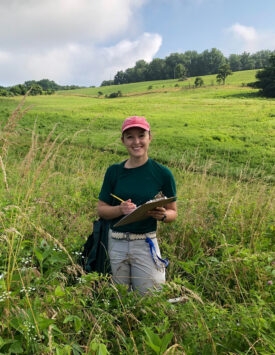Jordan Coscia
IGC FELLOW | Global Change Center
Ph.D. Candidate • School of Plant and Environmental Sciences
Research Interests: Grassland ecology, community ecology, ecological restoration, botany
Advisor: Dr. Leighton Reid
jtcoscia@vt.edu

Jordan began her PhD under the mentorship of Dr. Leighton Reid in the School of Plant and Environmental Sciences in 2020. Her research on the conservation and restoration of grasslands in the American Southeast began with an internship at the Smithsonian Conservation Biology Institute’s Virginia Working Landscapes program (VWL), which she started shortly after her graduation for the University of Pittsburgh in 2019. At VWL, Jordan lead baseline vegetation surveys for an experimental grassland restoration project that would become a central part of her proposed dissertation research. Upon her acceptance to Tech, Jordan developed her internship with VWL into a Smithsonian Fellowship, where she continues to conduct collaborative research with the Oak Spring Garden Foundation, the Clifton Institute, and VWL’s network of landowners, researchers, and citizen scientists.
Jordan’s dissertation research focuses on the identification, restoration, and conservation of southeastern grasslands, one of the most endemic-species-rich ecosystems in North America. She has conducted surveys of remnant and semi-natural grasslands in northern Virginia to examine role of soil-related factors in the distribution of southeastern grasslands in the northernmost part of their range. She has also established a restoration experiment to determine the barriers to natural grassland regeneration by comparing the impacts of active and passive restoration techniques on southeastern grassland communities.
Jordan believes that though humankind has a complicated history of negative impact on the natural world, people can help guide the Earth’s recovery through collaboration and innovation. She aims to develop an interdisciplinary career that combines restoration ecology with human needs such as sustainable agriculture so that she may simultaneously contribute to the welfare of both humans and wildlife.




